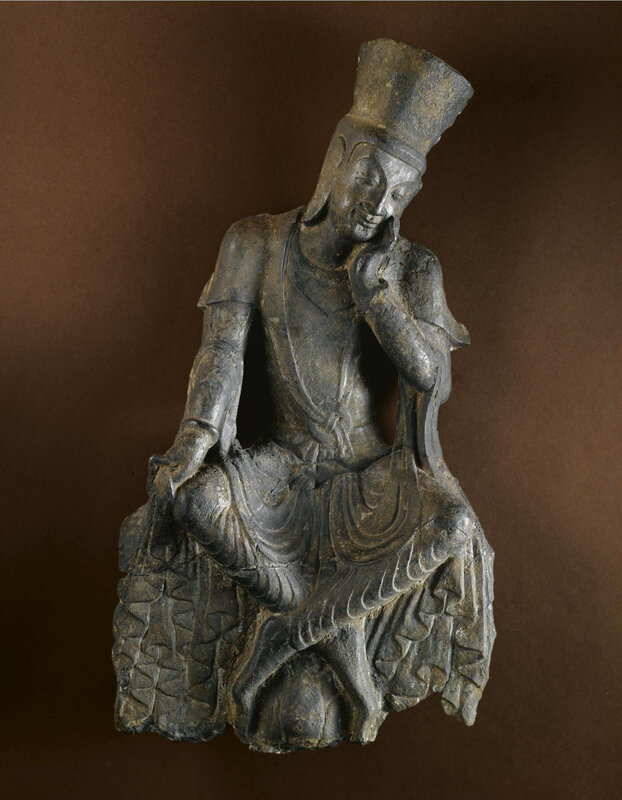A rare limestone seated figure of a 'Pensive' Maitreya, Northern Wei Dynasty, early 6th century, Longmen Caves
Lot 503. A rare limestone seated figure of a 'Pensive' Maitreya, Northern Wei Dynasty, early 6th century, Longmen Caves; 23 3/8 in., 59.5 cm. Estimate 300,000 — 500,000 USD. Lot sold 1,361,600 USD. Photo: Sotheby's.
the grey stone originally part of a wall fragment, deftly carved with the youthful prince seated upon a lotus pedestal base with legs crossed at the ankles, head bent slightly to its left and the left hand gently cradling its cheek in ‘pensive’ posture, the right hand resting on the knee clutching the folds of the thin dhoti cascading down the edge of the base and its legs in a series of rhythmic folds, stopping at the ankles to reveal the attenuated feet and toes softly dangling in relaxed gesture framing a lotus bud, the slender torso with tapered waist arched elegantly forward and left bare save for a stylized pectoral and thin shawl draped across the shoulders and tied around a small bi disc at the waist, the elongated earlobes and the tall flaring crown framing the slightly bulging eyes gazing down in contemplation below arched brows issuing from the curve of the broad nose, all above the full lips drawn in a tender smile, stand.
Provenance: Collection of Arthur B. Michael, Newton Center, MA (bequest of 1942).
Collection of Albright-Knox Art Gallery, Buffalo, New York, no. 1942:16.210.
Exhibited: Far Eastern Art in Upstate New York, Herbert F. Johnson Museum of Art, Cornell University, Ithaca, Albany, Utica, Syracuse, Rochester and Buffalo, 1976-1977, cat.no. 21 (illustrated).
Literature: Andrew C. Ritchie, Catalogue of the Paintings and Sculpture in the Permanent Collection, Albright Art Gallery, Buffalo, 1949, p. 212, no. 209.
Steven A. Nash, with Katy Kline, Charlotta Kotik and Emese Wood, Albright-Knox Art Gallery: Painting and Sculpture from Antiquity to 1942, Buffalo, 1979, pp. 84-85.
Note: The present figure of Maitreya Bodhisattva is carved in the distinctive style characteristic of the Longmen cave temples located south of Luoyang in Henan province. It has a face that conveys a focused, yet gentle and kind expression, suggesting contemplation and reflection and, overall, radiates a sense of peace and calmness. Although the broad shoulder and narrow waist draw the eye to the upper body, which is masculine in appearance, the long and slender arms and legs convey a sense of feminine fluidity and grace.
Maitreya Bodhisattva depicted seated with legs crossed at the ankles and the left hand raised in the ‘pensive’ posture are rare, although a very similar limestone figure currently in the Longmen Museum is illustrated in the museum’s catalogue Longmen Bowuguan, Zhengzhou, 2005, cat.no. 5. Another Longmen limestone bodhisattva depicted in this rare posture, now in the Asian Art Museum of San Francisco, is illustrated in René-Yvon Lefebvre d’Argencé (ed.), Chinese, Korean and Japanese Sculpture in the Avery Brundage Collection, San Francisco, 1974, pp. 98-99, pl. 37, where three further related examples are mentioned, one in the Allen Memorial Art Museum of Oberlin College, which originally came from the Binyang cave at Longmen, one with the head facing the other way in the City Art Museum of St. Louis, and a third example accompanied by lions in the Portland Art Museum, in Oregon. See also two figures, one in the Seattle Art Museum with the head facing the other way illustrated in Hai-wai yi-chen. Chinese Art in Overseas Collections. Buddhist Sculpture I, Taipei, 1986, pl. 27, and one from the collections of Alice Boney, New York, and James W. & Marilynn Alsdorf, Chicago, included in the exhibition Ancient Chinese Sculpture from the Alsdorf Collection and Others, Eskenazi, London, 1990, cat.no. 1.
The pose of the present and the above cited figures is unusual and rarely seen on sculptures from other cave temples. It appears to be related to the pose of the ‘Pensive Bodhisattva', who is usually depicted seated with head slightly inclined to the right, and cheek resting on the fingers of the raised right hand. The bodhisattva’s right leg rests on the pendant left leg, with the left hand lightly clasping the ankle. See an example in the William Hayes Fogg Art Museum, Harvard University, illustrated in Hai-wai yi-chen, op.cit., pl. 24, together with another in the Honolulu Academy of Arts, pl. 25.
Seated ‘Pensive Bodhisattva’ figures are generally identified as Maitreya or the Future Buddha, the successor of the historic Sakyamuni Buddha. It is believed that Maitreya will eventually appear on earth, achieve complete enlightenment and teach the pure dharma. The prophecy of the arrival of Maitreya is found in the canonical literature of all Buddhist sects including the Theravada, Mahayana and Vajrayana.
Maitreya Bodhisattva is also depicted seated with ankles crossed, the right hand raised in a teaching mudra and the left hand resting on the head of one of the two guardian lions seated at its feet or on its left knee. See two Longmen figures in the Museum Rietberg, Zurich, illustrated in Osvald Siren, Chinese Sculptures in the von der Heydt Collection, Zurich, 1959, pls. 11 and 12. Another figure also attributed to Longmen was included in the exhibition Ancient Chinese Sculpture, Eskenazi, London, 1978, cat.no. 8; one in The Metropolitan Museum of Art, New York, is included in Alan Priest, Chinese Sculpture in the Metropolitan Museum of Art, New York, 1944, pl. XXIII; and several figures in situ in the Guyang Cave at Longmen published in Longmen shiku, Beijing, 1980, pl. 25.
Sotheby's. Fine Chinese Ceramics and Works of Art, including Property from the Collection of the Albright-Knox Art Gallery, Buffalo, New York, 19-20 march 2007.

/https%3A%2F%2Fprofilepics.canalblog.com%2Fprofilepics%2F1%2F0%2F100183.jpg)
/https%3A%2F%2Fstorage.canalblog.com%2F03%2F02%2F119589%2F96711876_o.jpg)
/https%3A%2F%2Fstorage.canalblog.com%2F11%2F31%2F119589%2F94773502_o.jpg)
/https%3A%2F%2Fstorage.canalblog.com%2F20%2F83%2F119589%2F94772815_o.jpg)
/https%3A%2F%2Fstorage.canalblog.com%2F26%2F72%2F119589%2F75604929_o.jpg)
/https%3A%2F%2Fstorage.canalblog.com%2F59%2F60%2F119589%2F26458628_o.jpg)



/http%3A%2F%2Fstorage.canalblog.com%2F70%2F68%2F119589%2F129847829_o.jpg)
/http%3A%2F%2Fstorage.canalblog.com%2F73%2F24%2F119589%2F129777876_o.jpg)
/http%3A%2F%2Fstorage.canalblog.com%2F21%2F76%2F119589%2F129705240_o.jpg)
/http%3A%2F%2Fstorage.canalblog.com%2F43%2F93%2F119589%2F129481804_o.jpg)